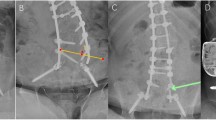Abstract
Study Design
Retrospective comparative cohort study.
Objectives
Identify whether there are patient or surgical risk factors to predict the probability of failure of iliac screw fixation after correction of neuromuscular scoliosis.
Summary of Background Data
There are high reported failure rates of pelvic fixation in long posterior spinal fusion (PSF) constructs to the sacrum for neuromuscular scoliosis.
Methods
Patients aged 5 to 25 years, at a single institution, had PSF to the sacrum from 2001 to 2009 with pelvic fixation using iliac screws. Clinical data were retrospectively reviewed to identify patient and surgical variables related to surgery. Failure of iliac fixation was identified strictly as a broken screw, disengagement of the screw from the connector or the connector from the rod, or set plug failure. Lucency around the screws greater than 2 mm was recorded but not considered a failure. Variables were analyzed in a statistical model to identify predictors of failure.
Results
A total of 108 patients met inclusion criteria; 100 (38 female and 62 male) had appropriate radiographs and minimum 2-year follow-up (average, 5.5 years). Coronal deformity correction averaged 59%. Most patients (89%) had fill of 6 of 8 possible distal fixation points composed of L4, L5, SI, and ilium bilaterally. Iliac screw failure occurred in 27 patients (27%). The initial single predictor statistical model identified 2 possible predictors of failure (patient: spastic tone; and surgical: absence of distal crosslink). In the multi-variable model, spastic tone remained a predictor of failure (p =.0103), whereas absence of distal crosslink bordered on significance (p =.0516).
Conclusions
Iliac screw fixation failure is common in patients with long PSF constructs for neuromuscular scoliosis. Spastic tone is a risk factor for failure of pelvic fixation. A distal crosslink may protect against pelvic fixation failure. Alternative techniques for pelvic fixation should be studied in an attempt to improve the failure rates of iliac screw pelvic fixation.
Similar content being viewed by others
References
Peelle MW, Lenke LG, Bridwell KH. Comparison of pelvic fixation techniques in neuromuscular spinal deformity correction: Galveston rod versus iliac and lumbosacral screws. Spine (Phila Pa 1976) 2006;31:2392–9.
Kuklo TR, Bridwell KH, Lewis SJ, et al. Minimum 2-year analysis of sacropelvic fixation and L5-S1 fusion using SI and iliac screws. Spine (Phila Pa 1976) 2001;26:1976–83.
Phillips JH, Gutheil JP, Knapp J. DR. Iliac screw fixation in neuromuscular scoliosis. Spine (Phila Pa 1976) 2007;32:1566–70.
Modi HN, Suh SW, Song HR, et al. Treatment of neuromuscular scoliosis with posterior-only pedicle screw fixation. J Orthop Surg Res 2008;3:23.
Harrop JS, Jeyamohan SB, Sharan A, et al. Iliac bolt fixation: an anatomic approach. J Spinal Disord Tech 2009;22:541–4.
Zahi R, Vialle R, Abelin K, et al. Spinopelvic fixation with iliosacral screws in neuromuscular spinal deformities: results in a prospective cohort of 62 patients. Childs Nerv Syst 2010;26:81–6.
Miladi LT, Ghanem IB, Draoui MM, et al. Iliosacral screw fixation for pelvic obliquity in neuromuscular scoliosis: a long-term follow-up study. Spine (Phila Pa 1976) 1997;22:1722–9.
Sponseller PD, Zimmerman RM, Ko PS, et al. Low profile pelvic fixation with the sacral alar iliac technique in the pediatric population improves results at two-year minimum follow-up. Spine (Phila Pa 1976) 2010;35:1887–92.
Lonstein JE, Koop SE, Novachek TF, et al. Results and complications after spinal fusion for neuromuscular scoliosis in cerebral palsy and static encephalopathy using luque galveston instrumentation: experience in 93 patients. Spine (Phila Pa 1976) 2012;37:583–91.
Nectoux E, Giacomelli MC, Karger C, et al. Complications of the Luque-Galveston scoliosis correction technique in paediatric cerebral palsy. Orthop Traumatol Surg Res 2010;96:354–61.
Myung KS, Lee C, Skaggs DL. Early failure of pelvic fixation in neuromuscular scoliosis. Paper presented at: Scoliosis Research Society 46th annual meeting and course; September 14–17, 2011; Louisville, KY.
O’Brien MF, Kuklo TR, Blanke KM, et al. Radiographic measurement manual. Spine Deformity Study Group (SDSG). Medtronic Sofamor Danek USA, Inc, 2004; Memphis, TN.
Author information
Authors and Affiliations
Corresponding author
Additional information
Author disclosures: SG (none); CH (none); JL (none); BM (none); ME (none).
Rights and permissions
About this article
Cite this article
Garg, S., Holland, C., LaGreca, J. et al. Predicting Failure of Iliac Fixation in Neuromuscular Spine Deformity. Spine Deform 2, 214–218 (2014). https://doi.org/10.1016/j.jspd.2014.01.002
Received:
Revised:
Accepted:
Published:
Issue Date:
DOI: https://doi.org/10.1016/j.jspd.2014.01.002




